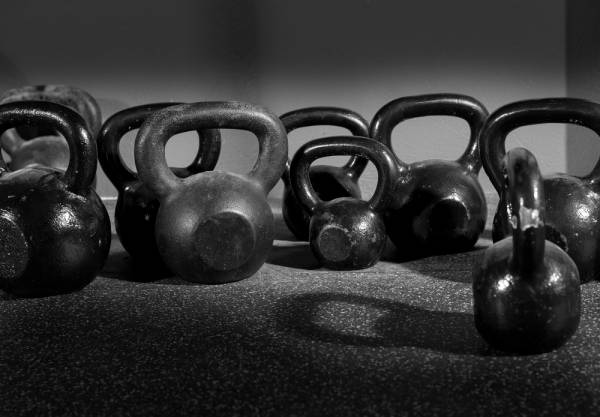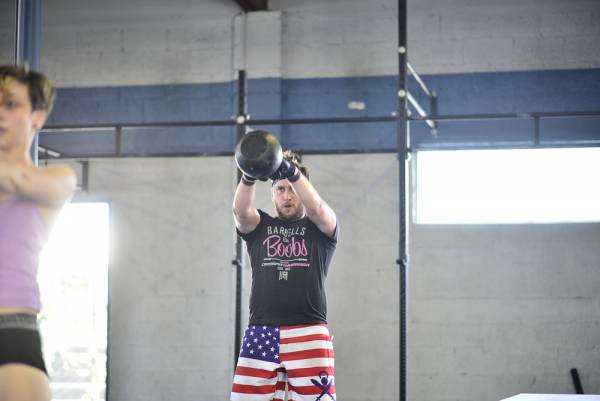No dropping weights. No grunting. Free pizza. These are all real things happening in fitness centers currently (although admittedly they’re all at the exact same place). But even if you go to other big gym chains, you’ll still see enough truly horrendous sights to make up your own “gym fails” compilation.
No dropping weights. No grunting. Free pizza. These are all real things happening in fitness centers currently (although admittedly they’re all at the exact same place). But even if you go to other big gym chains, you’ll still see enough truly horrendous sights to make up your own “gym fails” compilation.
How I Discovered Kettlebells
This is the point I was at in about 2006. I’d become sick of people asking me what I was doing when I was doing push presses and realized that if I didn’t find some other way to train I was likely going to murder someone. (And I’d already been thrown out of one gym for throwing a 2.5kg plate at someone who had annoyed me multiple times during my workout.)
So I started training at home. I had bought a few kettlebells and wanted to see just what was possible with these odd-shaped things. If you’re new to kettlebell training or thinking that you want to set up a home gym and use them, then this article is for you.
Kettlebells Aren’t Dangerous
Despite what many people will try to tell you, kettlebells aren’t dangerous. How can an inanimate object be dangerous? And if a kettlebell is dangerous, then how come a barbell or a Smith machine isn’t?
The only dangers when it comes to kettlebell training are all because of poor mechanics, which is true for all lifting. While the RKC has a strong reputation for how strict their form is, I’ve always wondered just why it’s such a big deal for everyone.
When it comes to safe and effective lifting technique, there is only one way and that is the one that allows you to lift safely 100% of the time.
That means if you want to get into training with kettlebells, the first step is to go and find a reputable instructor. Go find an HKC to teach you the basics or find an RKC or SFG to teach you beyond that. I know it means that you have to outlay a bit of money, but think of this as an investment.
Think of this money as your injury-prevention fund. The money spent here can be weighed against the thousands you’d otherwise need to spend later on for a doctor to fix all the problems you’d cause yourself.
An Investment for Life
The second thing you need to know is that you don’t need pairs of kettlebells. Unlike a barbell, which obviously has to be used with two hands, or a pair of dumbbells, a single kettlebell can give you a super tough workout all on its own.
In terms of weights to buy, it is generally recommended that men start with a 16kg and 24kg (35lb and 53lb respectively) and women with a 12kg and 16kg (25lb and 35lb). However, I’d qualify that by saying that these weights might be appropriate for those coming to kettlebell training with some experience with weight training already.
It’s more likely that most men new to strength training will need a 12kg and 16kg, and women will need an 8kg and 12kg.
This is where the next problem takes place – cost. Yes, kettlebells are expensive compared to dumbbells. However, a good kettlebell such as Dragon Door’s military-grade bells will last a lifetime.
I have bells at Read Performance Training that are now over five years old and have copped more abuse than garage gym bells ever will and they still look brand new, with no signs of chipping or rusting.
If you buy good quality to begin with, you’ll have tools to help keep you healthy, fit, and strong for the rest of your life, so that one-time investment won’t really be much when you look at what the yearly cost works out to be. (As an example, my 16kg bells have cost me less than $15/year so far, versus my Olympic bars, which have cost $125/year over the same time).

So, a good starting set of bells for a male would be 12kg, 16kg, 20kg, 24kg, and 32kg. While a good set up for women would be 8kg, 12kg, 16kg, and 24kg.
The reason for the final bell in each group is that if you’ve been taught correctly from the start, you’ll be able to do at least two-hand swings with a heavy bell quite quickly. But resist that temptation to buy two of each weight – just trust me on this.
Movement Quality and Strength
When you start looking for workout options to follow at home you need to keep three pillars of training in mind – movement quality, strength, and conditioning.
If you dig deeper into movement quality work, you’ll see that many FMS correctives can be done with a single kettlebell (and barely any with doubles, and those that are done with doubles are actually regressions for the single-bell option).
Along with this there are many great exercises like armbars, halos, and even windmills that are fantastic movement quality drills that don’t require two bells.
For strength work, I’d focus on two main exercises – the clean and press or clean and jerk. For raw beginners, I’d go with the clean and press as it’s easier to learn and patterning the press (a slow grinding move) first will lead to an easier time learning how to do jerks later.
This is another reason to seek the help of an RKC as the kettlebell clean is a tough move to get right. Learning to do it well from the start will save a lot of pain and bruising.

Conditioning: Swing First Then Snatch
The final pillar needed to support a well-rounded kettlebell training plan is conditioning. Swings of all types – dead swings, two-hand swings, and one-hand swings – are a great place to start.
Once you’ve mastered those, I’d suggest returning to your RKC and learning how to snatch. Resist the temptation to try to snatch early in your training. It’s only once the swing and your overhead position have been locked into place by many reps that learning the snatch becomes easy.
Once you’ve got a handle on all the basic kettlebell moves – swing, clean, squat, press, snatch, get up – I suggest a workout like Jon Engum’s Deep Six, which may be the single best home workout ever devised as you can do it in a tiny space with a single bell. Don’t be fooled by it either.
It’s an absolute killer that will give you ample movement, strength, and conditioning for just about everything life throws at you.
Photo 2 courtesy of Shutterstock.
Photo 3 courtesy of CrossFit Empirical.






